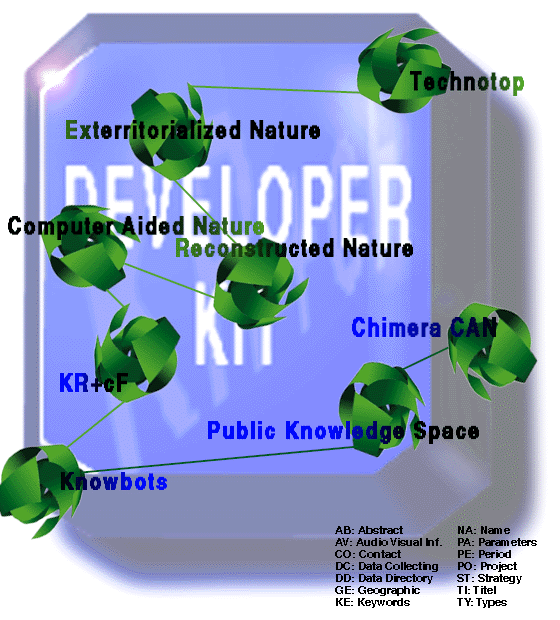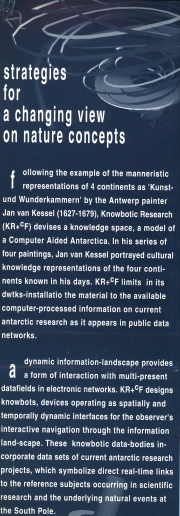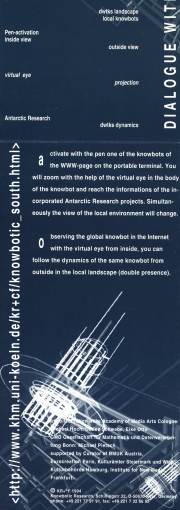
Developer Kit = The model of a process of confronting with the public appearance of scientifically collected and processed data series, mock-ups and simulations as representations of a conceptionable reality o Strategies for a dialogue with a changing view of nature based on the information sets provided by current Antarctic research
Technotop = A recorded series of measured values represent natural conditions in the form of digitally coded data structures. For the purpose of these transformation processes, Antarctica is surveyed (in the deep sea as in the orbit, in its pack ice as in volcanic craters) by a formidable array of automatic measuring instruments which, installed and maintained by scientists, observe and record natural phenomena as an extension of perceptual organs. These measuring instruments divide the entirety of nature into processable information units. Their sensory capacities are highly specialized and focused on individual phenomena which are additionally broken down into space and time fragments to generate information output. As a result, this fractalization of nature can only take into account the technologically perceptible structures of the Antarctic reference nature.
Exterritorialized Nature = The large volumes of acquired and corrected data representing Antarctica in our data bases are freely accessible via electronic networks, even to non-scientific users. The result is a digitized telepresence of reference nature in a public data world.
Reconstructed Nature = Natural scientists transform exterritorialized nature into models, formulating functional mathematical equations to reflect system effects as the might take place in the reference nature. These models are tested by simulation. Measured digital values fill the variables in these equations and are thus reorganized in a processual context of effect. Simulation provides a means of reconstructing natural processes which, in the exemplary case of Antarctica, mainly take place on an infinitely small or infinitely large scale, in inconceivable depths and complexities. These mathematically interpreted, invisible processes can be projected into the future to generate predictions that allow us to judge the effects of parameter manipulations. Nature becomes a concept.
Computer Aided Nature: The current scientific dialogue relies increasingly on this reconstructed form of nature. Answers are no longer supplied by reference nature via the experiment, but by the medium, i.e. the computer. At the same time, the dialogue is popularized in the sense that the 'Computertop', i.e. exterritorialized nature in all its digitally stored forms (data series, models, simulations), becomes generally accessible through public data networks. The circle of participants in the dialogue widens. Reconstructed nature detaches itself from its technological synthe-sizing process. It becomes in distance to its reference basis emancipated and assumes the role of an autonomous partner in the dialogue, emerging as Computer Aided Nature (CAN).
KR+cF The idea is to create a Public Knowledge Space in which a potential dialogue about a potential nature can take place. KR+cF devises an infrastructure for this hypothetical space and outlines plans for the development of processual objects. These 'agents' expose the confrontation with the dynamic complexities of reconstructed nature and attach it to a discourse on a potential Computer Aided Nature.
Knowbots = Knowbots embody the strategies which generate this dialogue on a hypothetical nature. System effects reconstructed in scientific simulations assimilated with continuously updated data series serve as input to the operations of the Knowbots. KR+cF combines strategies from the open field of Antarctic research interests to these operations, which are intended to coordinate a continuously re-calculated nature with its potential perceptibility and effectiveness. In this way, knowbots become the immaterial generators of differences and gaps in advanced system effects of a Computer Aided Nature.
Public Knowledge Space = An extension of the dialogue is achieved not through a recipe for a virtual nature (i.e. its mere perceptually illusive construction), but through the interaction with knowbots in aesthetic fields of the Public Knowledge Space. These fields are generated by the tension between the inadequacy of traditional concepts of nature in the face of technological and cultural developments on the one hand and the abstract conceivability of a Computer Aided Nature on the other. The result is a confrontation between the experiences of our historical (physical) presence in nature and the (spiritual) freedom prevailing in the Public Knowledge Space. The detachment from the reference nature is precondition for the emergence of these specific aesthetic fields. The knowbots outlined by KR+cF represent no static formalization. They can be modified as they interact with the participants present in the Public Knowledge Space. Knowbots are mobile in time and space and become multi-local and -present through copying in networks. Processes inside the knowbot can be linked to externally located contextual interests. The Public Knowledge Space thus creates a playground for modifying the possibilities (and hence, the formalizations and dynamics) of knowbots as part of an interdisciplinary discourse with a hypothetical nature.
Chimera CAN = The advanced Computer Aided Nature recombines natural system correlations with specific social, cultural and aesthetic components. This chimerical nature, unlike hermetically sealed virtual worlds, owe its existence to its linked effectiveness to the reality and is subject to the same cultural conditioning as our perception of the so-called reference nature. It is open to economic exploitation and political power play, operates as a knowledge-generating source, offers the potential for aesthetic experience, and can itself become the object of scientific research. Using current approaches in Antarctic research as its material, KR+cF thus devises a visionary interaction between the actual, the virtual and the hypothetical.
Developer Kit
1993
There was a lack of usable terms to describe our intentions. So we had tried to create special ones.



the first flyer